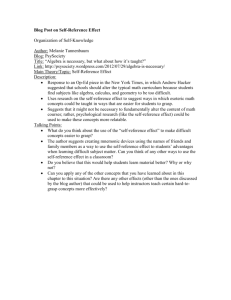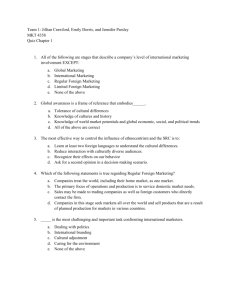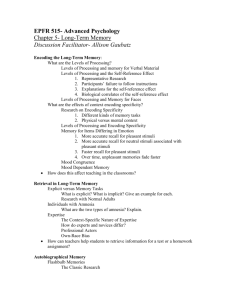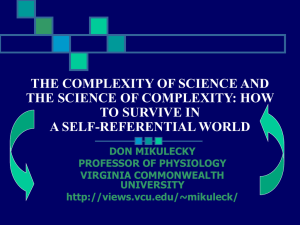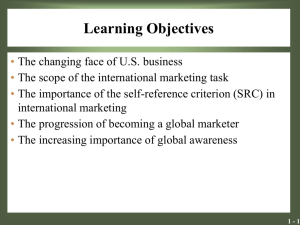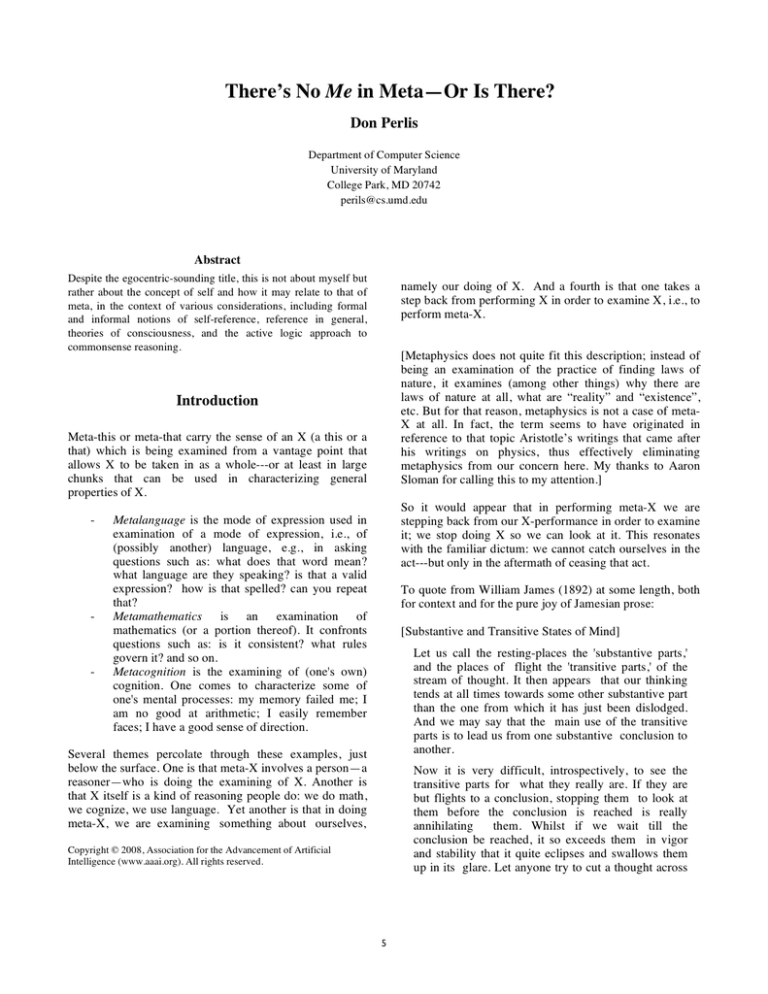
There’s No Me in Meta—Or Is There?
Don Perlis
Department of Computer Science
University of Maryland
College Park, MD 20742
perils@cs.umd.edu
Abstract
Despite the egocentric-sounding title, this is not about myself but
rather about the concept of self and how it may relate to that of
meta, in the context of various considerations, including formal
and informal notions of self-reference, reference in general,
theories of consciousness, and the active logic approach to
commonsense reasoning.
namely our doing of X. And a fourth is that one takes a
step back from performing X in order to examine X, i.e., to
perform meta-X.
[Metaphysics does not quite fit this description; instead of
being an examination of the practice of finding laws of
nature, it examines (among other things) why there are
laws of nature at all, what are “reality” and “existence”,
etc. But for that reason, metaphysics is not a case of metaX at all. In fact, the term seems to have originated in
reference to that topic Aristotle’s writings that came after
his writings on physics, thus effectively eliminating
metaphysics from our concern here. My thanks to Aaron
Sloman for calling this to my attention.]
Introduction
Meta-this or meta-that carry the sense of an X (a this or a
that) which is being examined from a vantage point that
allows X to be taken in as a whole---or at least in large
chunks that can be used in characterizing general
properties of X.
-
-
-
So it would appear that in performing meta-X we are
stepping back from our X-performance in order to examine
it; we stop doing X so we can look at it. This resonates
with the familiar dictum: we cannot catch ourselves in the
act---but only in the aftermath of ceasing that act.
Metalanguage is the mode of expression used in
examination of a mode of expression, i.e., of
(possibly another) language, e.g., in asking
questions such as: what does that word mean?
what language are they speaking? is that a valid
expression? how is that spelled? can you repeat
that?
Metamathematics is an
examination of
mathematics (or a portion thereof). It confronts
questions such as: is it consistent? what rules
govern it? and so on.
Metacognition is the examining of (one's own)
cognition. One comes to characterize some of
one's mental processes: my memory failed me; I
am no good at arithmetic; I easily remember
faces; I have a good sense of direction.
To quote from William James (1892) at some length, both
for context and for the pure joy of Jamesian prose:
[Substantive and Transitive States of Mind]
Let us call the resting-places the 'substantive parts,'
and the places of flight the 'transitive parts,' of the
stream of thought. It then appears that our thinking
tends at all times towards some other substantive part
than the one from which it has just been dislodged.
And we may say that the main use of the transitive
parts is to lead us from one substantive conclusion to
another.
Several themes percolate through these examples, just
below the surface. One is that meta-X involves a person—a
reasoner—who is doing the examining of X. Another is
that X itself is a kind of reasoning people do: we do math,
we cognize, we use language. Yet another is that in doing
meta-X, we are examining something about ourselves,
Now it is very difficult, introspectively, to see the
transitive parts for what they really are. If they are
but flights to a conclusion, stopping them to look at
them before the conclusion is reached is really
annihilating
them. Whilst if we wait till the
conclusion be reached, it so exceeds them in vigor
and stability that it quite eclipses and swallows them
up in its glare. Let anyone try to cut a thought across
Copyright © 2008, Association for the Advancement of Artificial
Intelligence (www.aaai.org). All rights reserved.
5
in the middle and get a look at its section, and he will
see how difficult the introspective observation of the
transitive tracts is. The rush of the thought is so
headlong that it almost always brings us up at the
conclusion before we can rest it. Or if our purpose is
nimble enough and we do arrest it, it ceases forthwith
to itself. As a snowflake crystal caught in the warm
hand is no longer a crystal but a drop, so, instead of
catching the feeling of relation moving to its term, we
find we have caught some substantive thing, usually
the last word we were pronouncing, statically taken,
and with its function, tendency, and particular
meaning in the sentence quite evaporated. The attempt
at introspective analysis in these cases is in fact like
seizing a spinning top to catch its motion, or trying to
turn up the gas quickly enough to see how the
darkness looks....
Informal self-reference
Perhaps the most famous example of a self-referential
utterance is the so-called Liar:
L:
This sentence is false.
The Liar, or L for short, has two curious features: (i) it
appears to refer to itself, and (ii) it appears to contradict
itself. The latter feature is the one that has received most
attention, but we will focus instead on the former. At this
early stage let us simply note that there is an issue as to
what, if anything, can guarantee that the word “This” in L
succeeds in referring to L itself, as opposed (say) to some
other sentence that may have recently been uttered or
pointed to. Presumably it is our agreement that it so refer;
but then there is personal agency involved.
Yet in metamathematics it turns out that (for example via
Godel numbering) a good deal of the meta-X (X being
mathematics) is itself part of X. To be sure, the concerns or
aims of meta-X are not quite the same as those of X; but
there is a large overlap of the two, at least in this case. And
the typical metalanguage for a natural language—say
English, for example—is English itself.
Consider these two sentences that directly speak to
personal agency:
I am using the letter “L” to refer to the sentence to the
right of that letter.
The above sentence calls attention specifically to how an
expression is to be taken as referring, according to the
agent-speaker.
So, here is the theme/poser of this essay: when we examine
our performance of a cognitive activity X, must that
examining (itself an activity) effectively halt our Xperformance, or at least so change it that it no longer is
what we were attempting to examine? And if so, can bit
then be examined in pristine only from without, by a
highly distinct process? Or can one perform a mental
activity that continues full-blast (“in a headlong rush”, to
borrow from James) even while being looked at from
within—perhaps even an activity that is that very looking
at its own performance of itself? Answers tend to involve
one of two notions which we may refer to as hierarchical
(looker is separate from lookee) or loopy (looker and
lookee can be intertwined and even one and the same).
These terms will be further explained as we proceed.
Here I am speaking in English in Chicago as I scratch
my head, wondering how I will complete this
sentence that I will complete…now.
In this sentence there is no explicit mention of reference or
meaning, but words such as “Here” and “I” must be
understood as referring to the present time and to the
speaker. Moreover, surely this sentence is true—or was
true when it was uttered—and surely in uttering it I
referred to myself and to that very sentence-uttering
process as it was occurring. The process refers to itself,
wearing, so to speak, its meaning on its sleeve, and it
achieves that in virtue of my decision to make it do that
and of your understanding that this is what I am doing.
However, it seems clear that the notion of a self, or a me, is
near and dear to the theme at hand. And now I hope the
meaning of the title is somewhat clearer as well.
Perhaps more precisely, I am referring to my uttering
activity as it occurs, and that referring action is simply that
very uttering activity itself. The uttering activity is a selfreferring process. Not the sentence, but the activity. What
activity? Not mere production of words. Uttering in this
context is supposed to mean something like: attempting to
convey something to someone, and the self-referential
uttering activity is one that is (or involves) an attempt to
convey itself—i.e., its own self-conveyingness—to
someone.
Consideration of our theme will lead us to a number of
traditionally far-flung topics: informal (natural-language
based)
self-reference;
formal
self-reference
in
mathematical logic; the problem of reference in general;
consciousness; commonsense reasoning; and mistakes.
We will now take these up in turn.
But this then rests upon a clear reference for “I”,
presumably once again an agent with referential intentions,
a matter seemingly far removed from the usual concerns in
discussions of the Liar.
6
is —Thm g, and hence we get Godel's Theorem: either g is
unprovable in F (and thus true, in the sense that what it
``asserts''---its own unprovability---holds), or F is
inconsistent (since if g is provable then so are both Thm g
and —Thm g .)
Pretty weird stuff. Self-referring entities tend to be
suspect; yet instead of being accidental oddities that creep
in because the expressive power of our languages (formal
or otherwise) is too lax, they are essential. In fact, the very
possibility of reference of any kind supervenes on a special
kind of self-reference, that I have called strong selfreference, that will come up again later.
But such formal results are purely syntactic, and reference
(let alone self-reference) plays no real role. For example,
that L refers to anything is irrelevant to the proof that the
formal version of the Liar is inconsistent. And the Godel
sentence g does not really refer to anything at all, let alone
to its own unprovability.
Indeed, as Grice (1957) has urged, every utterance is
implicitly of this sort, a self-commenting or self-meta-self,
as if it were of the form:
With this utterance I am attempting to convey the
meaning of this utterance to you.
And who cares? Isn't self-reference just a curiosity?---an
accident arising as a side-effect of an over-expressive
language, with surprisingly useful but equally accidental
application in formal logic, and of no deep significance in
itself?
Cannot we then simply ignore the bad
(contradictory) cases and welcome the good? As it turns
out, we cannot: self-reference, far from being an
unimportant side-effect, is central to reference, hence to
meaning, and arguably to meta-X as well. This leads us to
set out two highly dissimilar approaches to meaning
assignment.
Well, that might not work, it’s not clear it has a lot of
meaning. But the Chicago utterance-process above has a
clear meaning. It is also clear that it is an attempt to convey
something, and that that something is that very process
itself.
One natural-enough reaction to the above circumstances is
to suppose that some sentences (such as the Liar) are, after
all, neither true nor false, indeed neither true nor not true.
This may seem to play fast and loose with the word “not”'--after all, “not” simply asserts the failure of what follows
it. But perhaps there is something hidden here. In order to
be a candidate for failure in the matter of its truth, any
sentence must first have a potential truth that can fail, i.e.,
it must have a clear enough meaning that can be measured
against some criterion of truth. How does a sentence
acquire a meaning? This is the subject of much dispute,
and we will return to it a bit later on.
[I should point out that there has been a tremendous
amount of work done on paradoxes of self-reference,
formal and informal. For example, Gilmore (1974) and
Kripke (1975) in particular have formulated two closely
related approaches that not only defuse the paradoxical
(contradictory) aspects but also retain (much of) the selfreferential aspects. The focus of such work in general has
been on clarifying the notion of truth, which is slightly
tangential to our concerns here.]
Formal self-reference
Hierarchical or Loopy?
The examples we have considered so far are informal,
based largely on commonsense notions. However, it is not
hard to capture similar behaviors in more formal dress. A
key component of the formalization is the Diagonal
Lemma, which asserts that in any reasonably expressive
formal theory F, for each unary wff Px there is a sentence p
such that in F it is provable that p —Pp. Given the
Diagonal Lemma various formal results along the lines of
the Liar follow.
Since the above formal results are just that, formal
(syntactic) and not dependent on semantics, then it might
be possible to keep the advantages of certain “seeming”
self-reference (as in Godel's Theorem) without the
disadvantages of the Liar (such as inconsistency). Tarski
showed how to do this by means of a restriction on how
languages refer. He posited a hierarchy of languages L_1,
L_2, … where each L_(j+1) has expressions that refer only
to objects in a previously defined language L_j. There is
then no expression that can refer to itself. This approach
simply banishes self-reference from expression altogether,
while leaving intact the syntactic vestiges needed for the
Diagonal Lemma (and useful formal results).
With more work (Godel) one can devise a wff Thm of F
such that, for all sentences s, Thm s is provable in F if and
only if s is provable in F; that is, Thm is a provabilitypredicate for F.
On the other hand, this hierarchal approach seems to
banish too much. There are perfectly innocuous but
semantically-based cases of self-reference, such as:
Now from the Diagonal Lemma, there is a sentence g (a
so-called Godel sentence) such that in F it is provable that
g —Thm g, i.e., that g is equivalent to its own
unprovability in F. It follows that if g is provable, then so
This sentence has five words.
7
So, as far as the hierarchical approach goes, a map between
symbols and referents is arbitrary, leaning on a decision to
use that map, and not some other, by an agent who intends
to use that map. Contrary to what Putnam (1975) has
claimed, meaning is (at least partly, and very significantly)
in the head (of the agent using that meaning). Only when
this issue is faced head on, do we encounter genuine cases
of reference, and the possibility of genuinely self-referring
expressions. And these turn out to be precisely the loopy
cases.
Yet this is not expressible in the Tarski Hierarchy. Nor is
the following pair of straightforward sentences, each
referring to the other (one happens to be false):
The sentence below has seven words.
The sentence above has six words.
Yet if these are clear enough, if a sentence can clearly refer
to another specific sentence, above or below itself, then
why not to itself?
The sentence right at this spot is in English.
General reference
For that matter, in referring to something above itself, a
sentence implicitly refers to its own position to give
meaning to “above” or “below”. Since the meanings of
some sentences are not captured hierarchically, we will
borrow a phrase of Hofstadter’s (2007), and say they have
loopy semantics.
A lesson we draw is that self-reference proper has largely
been left untouched by the very large literature purportedly
on that subject. This is because reference has largely been
left untouched, or rather pushed to the sidelines, via Godel
numbering or a similar artificial mechanism that leans on
external agreements to bring reference in at all. Attention
has focused, rather, on formal counterparts of selfreference that do, to be sure, carry with them a substantial
potential for contradictoriness, in close analogy to their
informal—but more genuinely self-referential—sources.
But while this attention has produced much of great
importance, it has left much out as well. First and
foremost is this problem: can there be representation
(meaning, reference) without an agent who chooses to so
represent? And secondarily, what is the relation between
reference in general, and self-reference? Third, what can be
said about “genuine” informal self-referential expressions,
in light of answers to the former questions? Space does not
permit a detailed discussion, but my answers are: no
representation without intentional stipulative agency,
reference supervenes on self-reference, and genuine or
“strong” self-reference is a special “loopy” agency
bordering on consciousness.
How does meta-X bear on hierarchical or loopy semantics?
The hierarchical case is simple enough: each language
L_(j+1) is a meta-language for the previous one, it takes a
step back, provides the vantage point, for commenting on
other sentences. There is no me in these sentences since
they always refer to another domain, never to the one
where they sit.
Loopy semantics, on the other hand, is precisely that of
sentences that self-refer, whether directly, or indirectly via
(a loop through) other sentences such as in the pair above.
But is this then not also simple, straightforward? Yes and
no. Here is where we start to see some complexities in the
concept meaning.
The problem, at its core, is that the hierarchical semantics
does not really address reference at all. In postulating that
language L_(j+1) is “about” objects (e.g., sentences) in
L_j, one is simply making a stipulation, not explicating
what it is for a sentence to mean anything, or refer. It is
only by means of an agreement among whichever logicians
happen to be participating in the discussion, that an
expression refers to anything at all.
Consciousness
Wait a minute! Consciousness? Aren’t we aimed at
understanding meta-X here?
The deictic “this” of natural language (as in “This sentence
is false.”) has been by-passed altogether in formal
treatments. Indeed, reference (or semantics) of any kind is
traditionally placed outside a formal language, as a
function defined on expressions in the language, mapping
to an external domain. The language in question does not
typically have an expression that stands in for this
function; and even if it did, what would determine that
standing-in relation? It is as if meaning, or truth, is always
one step removed, leaning on some agreement lying
outside whatever language is used.
Well, a me, a self, arguably is the essence of consciousness
(however, this is incredibly controverisal). But if so, and if
a me or a self is part of meta, then meta involves
consciousness. But we have seen two versions of meta:
hierarchical and loopy. The former is little more than a
sequence; the latter is mysterious. Hierarchical meta-X
presumably is akin to a Tarskian pair of levels, the object
level X and the monitoring level meta-X. There seems little
more to be said about it, except that someone sets up a map
by which the expressions at the meta-X level refer to items
at the X level. But then whoever sets up this map is really
8
the determiner of meanings, without whom there is no
particular designated map, and X and supposed meta-X
have no particular relationship. And meaning determiners,
as far as we know, are always people, or at least agents
with intentions.
This may be what is suggested in Piet Hein's poem Evening
and Morning Son—About falling asleep and waking up
(1972) [my thanks to Torkil Heiede for bringing this poem
to my attention]:
The world disappears,
a loop running smaller, until
the thread is drawn out,
and the space it encloses is nil.
We are faced then once again with agents: agents that
perform activities and also refer to those activities (some of
which are self-referring).
Consider again that English is its own metalanguage. We
typically talk about English in English, and for the most
part do not need a special set of meta-English terms to do
this, beyond ones such as “word” and “means” and “spell”
and “sentence”. But even here, such terms refer to bits of
English only because at least one human has taken them to
so refer.
Newborn of nothing,
reluctantly starting to be,
fumbling awareness awakens
and finds that it's me.
Let us step back a little from such tenuous speculations, to
a more engineering perspective, following an idea of John
Perry (1979). He describes pushing his shopping cart
along in an attempt to find the shopper whose cart is
leaving a trail of sugar on the floor, only later to realize he
is that shopper. But what is it that he learns? Perry explores
this question at some length, for although on the one hand
it seems obvious, on the other it is devilishly hard to say
what it is. Still, it seems to matter, and not only for
egocentric reasons. Our everyday actions seem tied to it.
What is it, then, for an agent to “take” one thing to “refer”
to another? Consider a primitive case: coining an
expression, explicitly linking a symbol s to a referent r.
This would seem to be no more nor less than an intention
to use s as a stand-in for r in certain contexts. Following
this trail, we now ask what it is to intend something, and
we are smack dab in the middle of both philosophy of
language and philosophy of mind. And to reinvoke Grice,
every utterance is a case not merely of intending, but also
of intending listeners to understand that the utterer intends
that intending. Can all this happen in the absence of a
fairly sophisticated (and quite possibly conscious)
cognitive engine? Moreover, the natural languages that we
use for expression of intentions are—as noted—their own
metalanguages, allowing loopy self-reference made
possible by our intentions to so refer: we speak of
ourselves, not just past or future, but our immediate present
self and present activity including the activity of noting
that activity.
Commonsense reasoning
We can ask a related question about robot design. Consider
a robot that can decide it is the robot who is leaking oil,
upon hearing that robot #17 is leaking oil. What is it for
robot #17 to know that it, itself, is that robot? How does
this affect its behavior? Presumably it is quite important to
have such a capability, e.g., for survival. See (Anderson
and Perlis 2005) for more elaborate discussion of this idea.
So, once again, does meta have a me? If meta involves
reference, and if reference involves agency with intentions,
including intentional self-referring activity, and if that in
turn is at least a hint of a self, then yes.
Thus a bare-bones agent self-reference may be the most
basic kind of reference. What is bare-bones self-reference
like? Imagine yourself stripped little by little of this
sensation, that thought, until all that is left is your own
grasp of being there, a bare loopiness without—for the
moment—any further trappings: no personal history, no
connections with or knowledge of entities in the world
other than the one thing: you-as-bare-awareness.
It is worth stopping to ask what good such a thing might be
(whether full-blast or loopy). One answer seems easy to
come by: the self-examining that consciousness appears to
provide has survival value. And in fact, much of recent
work in AI has been aimed at providing useful selfexamining capacities to automated systems, including
commonsense reasoners. Indeed, that is presumably what
this workshop is about. I turn then to an approach central
to my own work, that not only seems to promise some
usefulness for AI systems, but also bears a bit on some of
the other issues we have been exploring. Namely, I will
briefly discuss active logic.
Such a minimal subjective state—if there is such a thing—I
have dubbed the “ur-quale”: the most primitive sensation
or feeling possible, namely that of simply being a being, an
entity whose one activity is self-monitoringness (Perlis
1997, 2000).
Active logic is a type of “commonsense formal inference
engine”; that is, it consists of a language and rules of
9
More specifically:
inference, but with a twist: the rules are sensitive to the
actual physical passage of time. Thus the inference of Q
from P and PQ is sanctioned only if that inference
occurs at a time t+1 when both P and PQ had been
inferred at time t. In effect, time values are part of the
language; but that in itself is no news: temporal logics have
such as well. Active logic however ties time values to
actual physical time-passage, by keeping track of the
evolving current time. The active logic sentence Now(t)
has the obvious meaning. But what is striking is the socalled “clock” rule: from Now(t) infer Now(t+1). So we
have a sentence which—if believe—leads to its own
disbelief. The reason of course is that such a belief is timesensitive, and as time passes the belief becomes outdated.
But it has major consequences for what active logic can do.
For just one example, it facilitates a smooth handling of
contradictions. On the other hand, semantics becomes
much more complex; see (Anderson et al, 2008).
(i)
(ii)
(iii)
(iv)
I bring this up because active logic also provides a useful
way to talk about differences, or the lack of differences,
between metareasoning and object reasoning since the two
are not distinguished at all in active logic. Each inference
step involves looking back at the previous step to see what
was inferred then, and on that basis drawing inferences at
the new current step. Whether such an inference is modus
ponens, based on the presence of P and PQ at the
previous step, or instead is based on the presence of P and
—P and yields Contradiction(t) (recording the fact that
there was a direct contradiction at the previous step),
makes no difference at all to the machinery. It is only to us
that these inferences seem to exist at different levels, and
then only if we are sensitized to X vs. meta-X as a
hierarchical distinction from a young age in a formal logic
class.
(v)
(vi)
There is much more to be said, but we shall leave it and
turn instead to the practical matter of mistakes.
(vii)
Meta and mistakes
(viii)
As a technical branch of AI, commonsense reasoning is the
subject of a great deal of study. Yet (as with many such
things) there is no general agreement as to what it is, at
least in sharp definitional terms.
CSR consists of a module that notes
mismatches between observation and
expectation in a system’s performance,
assesses any such, and guides a response into
place.
This is the essence of human common sense.
We have expectations, note deviations from
them, and decide on a response.
Such a CSR module need not know much at
all about the system in question, other than
having access to at least some of the system’s
pre- and post- conditions (expectations) for
its actions and at least some of its
observations (e.g., sensor readings).
This module can be fairly simple, based on a
core set of general kinds of things that can go
wrong and general kinds of fixes for them.
For instance: noise can interfere with sensor
readings, in which case one can use another
sensor or take repeated readings, or replace
the sensor; data can be contradictory, and one
can distrust one or more of the
contradictands, seek corroborating evidence
for them, change its expectations, give up and
work on another problem, ask for help, etc.
The actual carrying out of such a response is
not the CSR module’s job; it merely
recommends, and the system must then be
equipped for the repair.
One particularly interesting case is that of a
failure due to lack of some skill, so that
training is needed. Training then can be
recommended by the CSR module, and if
training commences, the module monitors
that, assesses its progress, and recommends
when to stop training (whether due to its not
working, or to its having succeeded).
If such a module were to be built and put to
use with a given AI system, that system
would become far less brittle, and vastly
better at dealing with anomalies, than any AI
systems at present.
Such a module could be general purpose, not
built for any specific system or domain. This
is because humans are not specific in that
sense. We manage to muddle through in a
wide variety of unanticipated changes.
Here is my own definition, offered as a kind of hypothesis.
We are in fact hard at work designing just such a module—
as an outgrowth of active logic—which we call the
metacognitive loop; see (Anderson et al 2006).
Commonsense reasoning (CSR) is the form of
metareasoning that monitors an activity for mistakes and
then deals with them, sparing the main activity the
embarrassment of making a fool of (or destroying) itself.
10
It is time to move on—and so with this utterance I end my
talk.
Conclusion
What then can we say about our poser: is there is or is
there not a me in meta? Well, to the extent that common
garden variety so-called self-monitoring systems are
“meta”, the answer seems to be a clear no. One part of a
system can monitor another without any self-reference at
all, as if the two parts were in effect distinct systems, one
watching the other.
References
Anderson, M., Gomaa, W., Grant, J., and Perlis, D. 2008.
Active logic semantics for a single agent in a static world.
Artificial Intelligence. To appear.
Anderson, M., Oates, T., Chong, W., and Perlis, D. 2006.
The metacognitive loop I: Enhancing reinforcement
learning with metacognitive monitoring and control for
improved perturbation tolerance. Journal of Experimental
and Theoretical Artificial Intelligence. 18(3): 387—411.
In the case of active logic’s form of meta-X, the answer
appears to be a weaker no. While there is (so far!) no sharp
notion of me or self in active logic, still an active logic
sentence might refer to itself by invoking a description of
itself (e.g., the first sentence inferred at time t). And there
can be loops, with one sentence referring to a later one yet
to come, which in turn may refer back to it.
Anderson, M. and Perlis, D. 2005. The roots of selfawareness. Phenomenology and the Cognitive Sciences.
4(3): 297—333.
But note that reasoning about a past or future or even
present, does not in itself constitute an activity that reasons
about its very self. And even in the case of the sentence
italicized above, the self-description is akin to Perry’s
describing himself in a third-person manner as “the person
who…” without having the special form of self-knowledge
indicated by use of the pronoun “me”.
Gilmore, P. 174. The consistency of partial set theory
without extensionality. In T.Jech, ed. Axiomatic Set Theory,
147—153. American Mathematical Society.
Grice, P. 1957. Meaning. Philosophical Review 66:377-88.
Hein, P. 1972. Grooks, IV. Doubleday, New York.
Even the metacognitive loop (MCL) in the form presented
above does not appear to embrace anything close to selfreference.
Hofstadter, D. 2007. I Am a Strange Loop. Basic Books.
James, W. 1892. The stream of consciousness. Psychology,
chapter XI. Cleveland & New York, World.
On the other hand, if MCL itself were to make mistakes
and need to catch them, things might get more selfreferentially interesting, especially if the mistake-noting
were in some sense part of the mistake. That might nudge
MCL (or active logic) toward more explicit (strong) selfreference.
Kripke, S. 1975. Outline of a theory of truth. Journal of
Philosophy 72:690—716.
Perlis, D. 1997. Consciousness as self-function. Journal of
Consciousness Studies.
Hw can such a thing be, and what could it possibly mean?
Consider this:
Perlis, D. 2000. What does it take to refer? Journal of
Consciousness Studies.
This activity is taking too long, it must be stopped,
including this very reasoning about it, so other things
get done.
Perry, J. 1979. The problem of the essential indexical.
Nous, 13:3—21.
We have not yet managed (or even tried very hard) to
produce such behavior. But it does seem that there is a
computational advantage to it: such a system would be able
not only to peer in on other processes and reason about and
control them; it would also be able to do so regarding the
very same peering process that it is performing at the
moment, so that it can get out of its own way, so to speak,
deciding to stop what it is doing—including that very
deciding—and move on to something else.
Putnam, H. 1975. The meaning of meaning. Mind,
Language and Reality. Cambridge Univ. Press.
11

